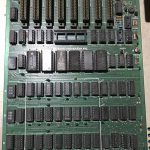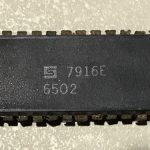I was reasonably settled in thinking, going by serial numbers, that I had mid-age to very young europluses (see my europlus Census).
However, my realisation that there was a lot of variation in the motherboard green colours led me to look more closely at them all and I realised that one motherboard had dark green (rather than black) slots with feet with fixing screw holes…and that got me looking at that motherboard more closely still (see Figure 1 below).
That motherboard is the only one without a date code – in the usual location it has written on it “APP031” (or “APPO31”). It also has the memory select blocks common on early revision motherboards, but it’s one of the three motherboards with a 65C02 I had incorrectly replaced the original 6502 with years ago, so I couldn’t check the date code on the original CPU.
Or could I?
I keep everything…I admit it, I’m a hoarder. I knew I had two of the three replaced 6502s in the antistatic tube my last unused 65C02 was in. Their date codes were 8135 and 8243, which seemed consistent with the date codes on the other 65C02 motherboards in 700105 and 667843 (4182 and 5182 respectively).
But I was sure I wouldn’t have only kept two of the three replaced 6502s, and I had a vague recollection of a loose 6502 in one of my small plastic boxes. Luckily, I knew where that box was, and when I checked, bingo! There was a 6502.
And oh, what a beautiful 6502 it was. Bent pins. Missing pins. Corroded pins. But, oh…that date code!
7916
For a europlus, that is early.
From what I’ve read, europluses were available from June 1979, and were manufactured until December 1982.
Given the style of motherboard, such an early CPU, and the number 31 as part of the writing where the motherboard date code should normally be, could it actually be a 7931 motherboard?
This site says the board’s revision (Revision 3, part number 820-0001-04 visible under CPU) was in production from roughly 7934 to 8030, so we’re in the ballpark.
7931 would be a manufacturing date in late July 1979. You wouldn’t find many surviving europluses that old. And I’ve got a 5182 motherboard – one of the last/youngest – along with several in between those two. The completist in me is quite satisfied with that sort of mix.
I knew other chips, such as memory chips, also have date codes on them, so I investigated their date codes…my heart started to sink a little: 8251, 8325, 8211, 8134 – these were not uncommon date codes I was seeing.
But I kept looking, and found others such as 7928, 7926, 7930, and one ROM’s date code of 7919.
I think at some point, probably in the early 1980s, this motherboard was refurbished with then-current components. Maybe it was even combined with the machine which originally had the serial number 669150 (which is the serial number on the base), as that’s right in the mid-range of serial numbers.
On that basis, I’m going to re-unite this early europlus motherboard with the early europlus base plate that I got during my Retrochallenge Roadtrip (614494) – I may also have an early keyboard and keyboard encoder that were with that early base plate, but that’s an investigation for another day.
I’ll then have an early europlus as part of my collection, which is a very nice feeling.
I’d be interested to hear what unexpected discoveries you’ve made in your collection in the Comments below.



One thought on “An Unexpected Discovery”
Comments are closed.